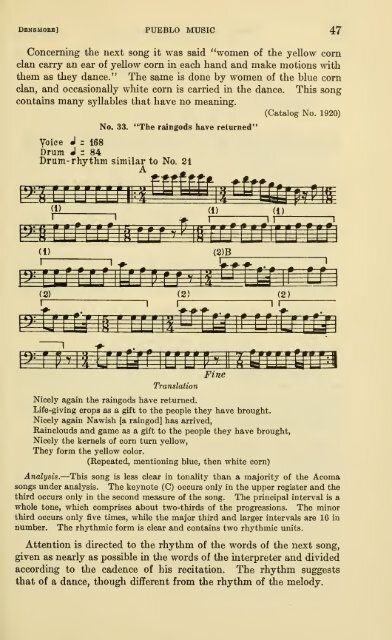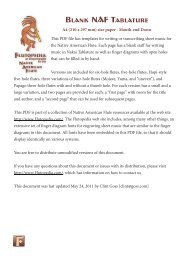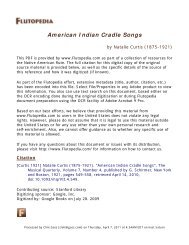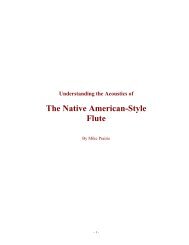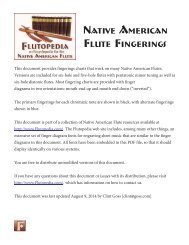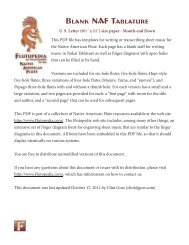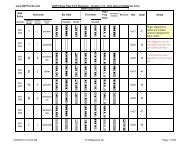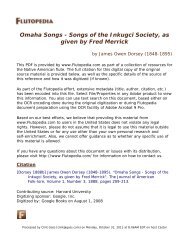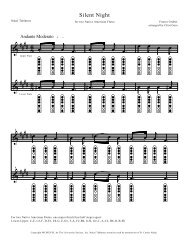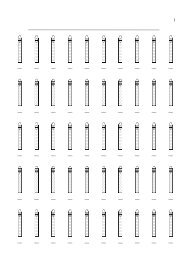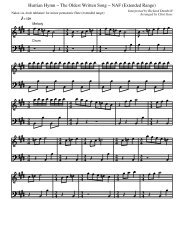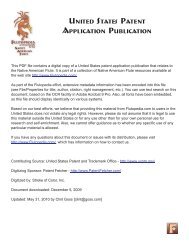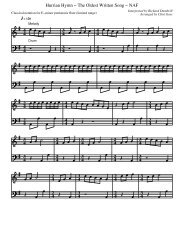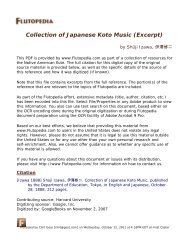Music of Acoma, Isleta, Cochiti, and Zuñi Pueblos - Flutopedia.com
Music of Acoma, Isleta, Cochiti, and Zuñi Pueblos - Flutopedia.com
Music of Acoma, Isleta, Cochiti, and Zuñi Pueblos - Flutopedia.com
Create successful ePaper yourself
Turn your PDF publications into a flip-book with our unique Google optimized e-Paper software.
Dbnsmobb] PUEBLO MUSIC 47<br />
Concerning the next song it was said "women <strong>of</strong> the yellow corn<br />
clan carry an ear <strong>of</strong> yellow corn in each h<strong>and</strong> <strong>and</strong> make motions with<br />
them as they dance." The same is done by women <strong>of</strong> the blue corn<br />
clan, <strong>and</strong> occasionally white corn is carried in the dance. This song<br />
contains many syllables that have no meaning.<br />
No. 33.<br />
Voice J = 168<br />
Drum J r 84<br />
Drum- rhythm similar to No. 21<br />
"The raingods have returned"<br />
(Catalog No. 1920)<br />
S<br />
li) .<br />
(1) (1)<br />
mzm<br />
itrrrvniirr<br />
IT<br />
p-F-rm E^3<br />
y)--fh \<br />
'iUmu rf^V':\\7dnm^<br />
Fine<br />
Translation<br />
Nicely again the raingods have returned.<br />
Life-giving crops as a gift to the people they have brought.<br />
Nicely again Nawish [a raingod] has arrived,<br />
Rainclouds <strong>and</strong> game as a gift to the people they have brought.<br />
Nicely the kernels <strong>of</strong> corn turn yellow,<br />
They form the yellow color.<br />
(Repeated, mentioning blue, then white corn)<br />
Analysis.—This song is less clear in tonality than a majority <strong>of</strong> the <strong>A<strong>com</strong>a</strong><br />
songs under analysis. The keynote (C) occurs only in the upper register <strong>and</strong> the<br />
third occurs only in the second measure <strong>of</strong> the song. The principal interval is a<br />
whole tone, which <strong>com</strong>prises about two-thirds <strong>of</strong> the progressions. The minor<br />
third occurs only five times, while the major third <strong>and</strong> larger intervals are 16 in<br />
number. The rhythmic form is clear <strong>and</strong> contains two rhythmic units.<br />
Attention is directed to the rhythm <strong>of</strong> the words <strong>of</strong> the next song,<br />
given as nearly as possible in the words <strong>of</strong> the interpreter <strong>and</strong> divided<br />
according to the cadence <strong>of</strong> his recitation. The rhythm suggests<br />
that <strong>of</strong> a dance, though different from the rhythm <strong>of</strong> the melody.


